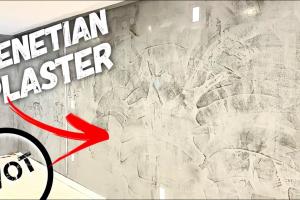Mastering Venetian Plaster: A Comprehensive Guide to Application and Techniques

-
Quick Links:
- What is Venetian Plaster?
- Benefits of Venetian Plaster
- Tools and Materials Needed
- Preparation Steps
- Application Techniques
- Finishing Touches
- Common Mistakes to Avoid
- Case Studies and Expert Insights
- FAQs
What is Venetian Plaster?
Venetian plaster is a traditional Italian wall finish made from lime-based plaster. It is known for its beautiful, textured appearance that can mimic marble or stone. This artisanal technique has been used for centuries in various architectural styles, particularly in the Mediterranean region. The result is a smooth, polished surface that reflects light, adding depth and warmth to any room.
Benefits of Venetian Plaster
- Durability: Venetian plaster is highly durable and resistant to cracking.
- Aesthetic Appeal: Its unique texture and sheen can enhance the visual appeal of any space.
- Eco-Friendly: Made from natural materials, it is a sustainable choice for interior finishes.
- Moisture Regulation: The lime component helps regulate humidity levels in a room.
- Versatility: It can be applied in various styles and colors to match your design vision.
Tools and Materials Needed
Before starting your Venetian plaster project, gather the following tools and materials:
- Venetian plaster (lime-based plaster)
- Putty knife or trowel
- Hawk (a flat tool for holding plaster)
- Sandpaper or a sanding block
- Painter's tape
- Primer (if required)
- Polishing pad or sponge
Preparation Steps
Proper preparation is key to achieving a flawless Venetian plaster finish. Follow these steps:
- Choose Your Surface: Ensure that the wall is clean, dry, and free of dust.
- Repair Any Damage: Fill in holes or cracks with spackle and sand smooth.
- Apply Primer: Depending on the surface and the plaster type, apply a primer if necessary.
- Tape Off Areas: Use painter's tape to protect edges and adjacent surfaces.
Application Techniques
Applying Venetian plaster involves multiple layers. Here’s a step-by-step guide:
- First Layer: Using the hawk and trowel, apply a thin layer of plaster. Work in small sections and aim for a smooth finish.
- Drying Time: Allow the first layer to dry completely, which may take several hours depending on humidity.
- Second Layer: Apply a second layer of plaster using a similar technique, but this time, create texture by changing the angle of your trowel.
- Polishing: Once the second layer is dry, you can polish the surface using a polishing pad to achieve a glossy finish.
Finishing Touches
After the application, consider adding a protective sealer to enhance durability and sheen. Follow the manufacturer's instructions for the best results.
Common Mistakes to Avoid
- Skipping the primer: Always prime for best adhesion.
- Applying too thick a layer: Thin layers allow for better drying and adhesion.
- Not allowing enough drying time: Patience is key to a good finish.
Case Studies and Expert Insights
In a recent project in a historic home in Venice, architects chose Venetian plaster to enhance the original aesthetic while ensuring modern durability. The application took about three days, including drying times, and resulted in a stunning, reflective finish that brought the space to life.
Expert insights suggest that mastering the application technique can take practice, but the results are worth the effort. “The beauty of Venetian plaster lies in its depth and texture,” says renowned interior designer Maria Rossi. “It transforms spaces in ways that paint simply cannot.”
FAQs
- How long does Venetian plaster last? With proper application and maintenance, Venetian plaster can last for decades.
- Is Venetian plaster waterproof? While it is water-resistant, it is not completely waterproof and should not be used in wet areas without a sealer.
- Can I apply Venetian plaster over existing paint? Yes, but ensure the surface is well-prepared and primed if necessary.
- How do I clean Venetian plaster? Use a damp cloth for regular cleaning; avoid harsh chemicals.
- Can I apply Venetian plaster myself? Yes! With some practice and the right tools, it’s a great DIY project.
- What colors are available for Venetian plaster? Venetian plaster can be tinted in a wide range of colors to suit your design needs.
- Is Venetian plaster expensive? It can be more costly than paint, but its durability and aesthetic appeal often justify the investment.
- Can Venetian plaster be used outdoors? It’s generally not recommended for outdoor use unless specially formulated for exterior applications.
- What is the drying time for Venetian plaster? Drying times can vary, but typically each layer should dry for at least 6-8 hours.
- Do I need professional help for the application? While professionals can provide expertise, many DIY enthusiasts successfully apply Venetian plaster themselves.
Random Reads
- How to measure in adobe illustrator
- How to measure inductance
- Safely clean laptop screen household products
- Safely remove water charging port
- Turn flash drive xbox 360 memory unit
- Turn off ad blocking google chrome
- Turn off s mode windows 11
- Unlock super smash bros brawl characters
- How to win at dice
- How to win at simcity 3000